
Oxon Cove Park and Oxon Cove Farm is a national historic district that includes a living farm museum operated by the National Park Service, and located at Oxon Hill, Prince George's County, Maryland. It is part of National Capital Parks-East. It was listed on the National Register of Historic Places in 2003.

The Guitar House, previously known as Confederate Hill, is a historic home located in Columbia, Missouri. It was built between 1859 and 1862 and is a two-story, Italianate style dwelling. It has a low-pitched hipped roof, tall slender windows with segmented arches, decorative eave brackets, and a single-story front porch with square supports. The house was constructed by David Guitar, an officer in the Union forces during the American Civil War. The house was added to the National Register of Historic Places in 1993.
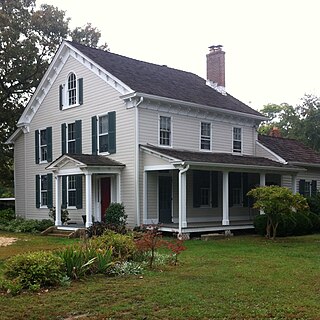
The old St. Mary's Rectory is a gable-front 21⁄2-story frame dwelling of three by three bays, built in 1849 and enlarged to twice its size in 1856, and located in Aquasco, Prince George's County, Maryland. The structure is significant for its architecture and for its association with the history of St. Paul's Parish and the community of Aquasco. The rectory is an excellent example of a vernacular building with Greek Revival and Italianate stylistic elements. The floor plan exemplifies a style typical of the dwellings of successful landowners and merchants of the mid-19th century in Prince George's County. Original Greek Revival style elements include the front gable entrance facade, crown molded returned cornice, porch detail, interior stair detail, door and window surrounds, and the parlor mantel. Italianate elements include the heavy bracketing of the exterior cornice and the tripartite window in the north gable end.
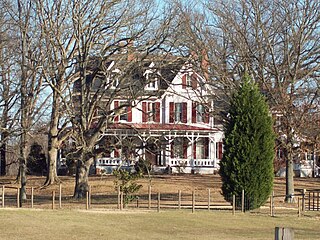
Villa DeSales, built in 1877–1878, is a large five-by-three bay, three-story frame High Victorian Gothic dwelling with a two-story south service wing, located at Aquasco, Prince George's County, Maryland. The historic home is significant for its architectural character which includes a complex of six 19th century outbuildings. This architectural style is an unusual one in Southern Maryland, an area heavily agricultural historically. The large size of the house, the decorative slate roof, amount and variety of cornice and gable trusses, brackets, and pendants; and the well preserved interior with original Gothic Revival-style lighting fixtures and parlor and bedroom furnishings make the house exceptional. In the rear yard are seven domestic and agricultural outbuildings in good condition. The stable is the only High Victorian Gothic barn or stable in Prince George's County.

The William W. Early House is a Queen Anne-style house located at Brandywine in Prince George's County, Maryland, United States, and is privately owned. It was constructed in 1907. According to a 1989 Historic American Buildings Survey report on the house, "The William W. Early House is probably the best example of turn-of-the-century Queen Anne-style domestic architecture in the county."
The James Hamilton House is a historic home located in Bowie, Prince George's County, Maryland, United States. The home was built in the mid-1870s, and is a 2+1⁄2-story gable-roofed frame Late Victorian house with Italianate detail. Outbuildings include a board-and-batten meat house contemporary with the house, a garage constructed in the 1950s, and a large concrete block dairy barn to the east of the house, constructed in the 1960s.

Hazelwood is a historic home located outside Upper Marlboro, Prince George's County, Maryland, United States. The home is a large asymmetrical frame dwelling, built in three discrete sections over a long period of time. They are: a low gambrel-roofed section dating from the 18th century, about 1770; a gable-roofed Federal-style dwelling dating from the very early 19th century; and a tall gable-front Italianate-style central section constructed about 1860. The house stands on high ground west of and overlooking the site of historic Queen Anne town on the Patuxent River. Also on the property are several domestic and agricultural outbuildings, and the reputed sites of two cemeteries.
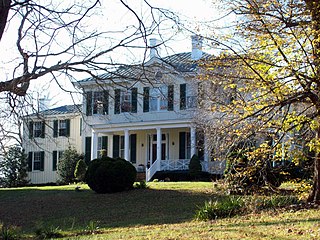
Waverly is a historic home located at Croom in Prince George's County, Maryland. The house, constructed in 1855, is a 2+1⁄2-story, two-part Italianate-style frame house. The casing of the principal entrance is a combination of both the Greek Revival and Italianate styles. Also on the property are two of the original outbuildings, a meathouse and a washhouse.
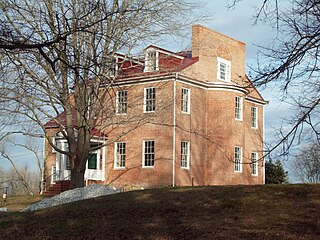
Melford is a historic plantation house located on the grounds of the Maryland Science and Technology Center, near the intersection of U.S. Route 301 and U.S. Route 50, at Bowie, Prince George's County, Maryland. The house is multi-part, gable-roofed, brick and stone dwelling house constructed probably in the mid-late 1840s, with elements of the Greek Revival style.

Melwood Park is a historic home located near Upper Marlboro in Prince George's County, Maryland, United States. It is a 2+1⁄2-story, Flemish bond brick structure, with Georgian details. As of 2009, it is undergoing an extensive restoration. This unique dwelling was visited by George Washington on several occasions and the British Army camped here during their march to Washington, D.C. in August 1814, during the War of 1812.

The Hyattsville Historic District is a residential neighborhood comprising a national historic district located in the city of Hyattsville, Prince George's County, Maryland. The district comprises approximately 600 structures, primarily houses, that exhibit late-19th and early-20th century design characteristics. The majority of residential buildings are of frame construction, the older ones with foundations of brick or (rarely) fieldstone, the newer of concrete. The architectural styles represented: grand "mansions," summer cottages, duplexes, Second Empire, Queen Anne, Italianate, Victorian, Bungalow, and Spanish. The area also includes numerous vernacular buildings. The finest concentration of late-19th century structures occur in the area of Farragut, Gallatin, and Hamilton streets and 42nd Avenue. The early-20th century hipped-roof style and bungalows are found throughout the district.

Dawson Farm, also known as "Rocky Glen," is a historic property with two homes located at Rockville, Montgomery County, Maryland. The property contains two dwellings: the 1874, 2+1⁄2-story, frame Dawson Farmhouse and a large 2+1⁄2-story hip-roofed frame house dating to 1912.

Richland is a historic home at Harwood, Anne Arundel County, Maryland. It is a 2+1⁄2-story, frame, hip-roofed dwelling of approximately 3,000 square feet (280 m2). It was constructed for gentleman farmer Robert Murray Cheston (1849–1904) and his wife, the former Mary Murray (1859–1943). It is the only known late-19th-century rural Anne Arundel County dwelling definitively associated with a specific architectural firm. The plans were prepared by the Roanoke, Virginia based architectural firm of Noland and de Saussure, founded by William C. Noland. The home reflects both the Colonial Revival and Queen Anne styles. The house on the 332 acre Richland farm was built in 1893. In the 1950s, the Cheston family subdivided the property and sold the house with approximately 58 acres to the Talliaferro family, and sold the remaining acreage to the Catterton family. The Talliaferro family named their new parcel "Thanksgiving Farm". In 1996, the Heimbuch family purchased Thanksgiving Farm from the Talliaferro family, began planting vineyards1998, completed a restoration of the house in 2004, and opened a winery on the property in 2006.
Hocking House is a historic home in Frostburg, Allegany County, Maryland, United States. It is a 2+1⁄2-story, three-bay, hip-roofed dwelling, built about 1855 in the transitional Greek Revival-Italianate architecture style. The land on which the home stands was part of the estate of Robert Clarke Sr., one of the original settlers of the area that is now Frostburg. It was converted into a clubhouse in 1942.

Merry Sherwood is a historic plantation house located at Berlin, Worcester County, Maryland, United States. It is a massive, three-story, five-bay, double-pile, frame dwelling, built about 1859 in the Italianate style. The house is topped by a flat roof, projecting cornice, and a large cupola. The roof of the cupola is capped with a pointed wooden spire. It is current operated as wedding and special event venue.

The George Markell Farmstead, also known as Arcadian Dairy Farm and the Thomas Property, is a historic home and farm complex located at Frederick, Frederick County, Maryland, United States. It consists of brick house built about 1865, a brick smokehouse, a bake oven, two stone domestic outbuildings, an ice house, a springhouse, a frame stable, a frame chicken house, a mid-20th century guest house, and various sheds and outbuildings. Nearby is a large gambrel-roofed concrete block barn. The main house has combined Greek Revival and Italianate stylistic influences. The once large Markell dairy farm, with its lane to the Ballenger Creek ford of the Monocacy River, served as the primary approach route to the battlefield by Confederate troops during the July 9, 1864 Battle of Monocacy during the American Civil War.
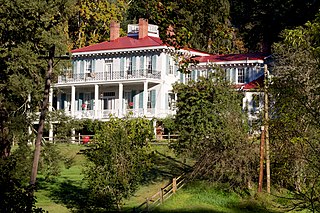
Glencoe is a historic home and resort complex located at Glencoe, Baltimore County, Maryland. It consists if a complex of Italianate-influenced domestic buildings and structures, clustered around a square, two-story frame dwelling. The house features a broad porch, which wraps around two sides with an iron-railed deck atop the porch. Four interior brick chimneys rise around a central observation deck. The property also includes a two-story, mansard roofed stable / carriage house, a smokehouse, ice house, sheep shed, garden house, and a latticed frame gazebo. It was built in 1851-1856 as a private residence, but was subsequently developed as a summer resort.

William T. Tull House, also known as E.D. Long House, is a historic home located at Westover, Somerset County, Maryland. It is a two-story, three-bay, center passage/double-pile plan frame dwelling, erected around 1860. Its exterior features are associated with the Greek Revival and Italianate styles.
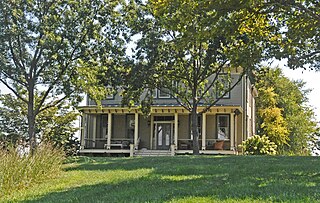
Gobbler Hill is a historic home located at Chestertown in Kent County, Maryland, United States. It was built in 1858 and is a center-hall plan frame house on a foundation of local fieldstone and brick. It is five bays wide, two bays deep, and two stories tall with late Greek Revival / early Italianate style details. It features a shallow hip roof surmounted by a tall belvedere and a full-width porch.

The Clagett House at Cool Spring Manor is a historic house in Prince George's County, Maryland, built around 1830 by William Digges Clagett on the family's Cool Spring Manor property. Constructed in a style more typical of the Deep South, it is a hip roofed wood frame dwelling standing on a brick foundation.






















